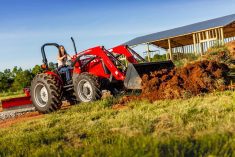In north-central Manitoba, a couple we’ll call Herb, 66, and Margie, 64, are planning retirement in just a few months. They have 320 acres they own personally. They have owned the land for almost 30 years. It will qualify for the farmland capital gains exemption. When sold, therefore, the property will not bear capital gains taxes provided the price of sale is less than $2.5 million.
They estimate its value at $1,280,000 or $4,000 per acre. On top of that, they have $225,000 in RRSPs and a house worth an estimated $200,000.
Farm Financial Planner asked Colin Sabourin, a certified financial planner with Harbourfront Wealth Management in Winnipeg, Man., for guidance.
Read Also

Gentle treatments for pain in the neck
Heading toward year-end, people unknowingly tense up against the cold and busyness, causing neck pain that can often be treated with appropriate support and gentle mobility, athletic therapist Kathlyn Hossack says.
The couple’s income goal in retirement, $70,000 per year after tax, will require some financial engineering, Sabourin explains. He notes they are currently generating $62,400 before tax. After tax, to get to $70,000, they will each need to produce $43,150 per year. At present, they will be short $23,900 per year in retirement.
Herb and Margie have $225,000 in total in their RRSPs. The best move is to convert them to registered retirement income funds now. Making a RRIF withdrawal of $2,000 or more each would allow them to access the pension credit on their tax returns, the planner explains. If they take a total of $23,900 out of their RRIFs that will leave them with $201,100.
Take inflation into account
It is essential to take inflation into account. From 1960 to 2021, inflation averaged 3.8 per cent per year. Recently, it has soared to as much as eight per cent nationally. For a compromise, for it is unlikely that inflation will persist for many years, we’ll use four per cent expected annual inflation for planning purposes.
For the next 10 years, let’s assume their expenses don’t change except rising with inflation. This means by 2033, they’ll need $103,617 after tax to buy the same things that $70,000 buys them today.
From ages 75 to 85, assuming expenses will be reduced by 20 per cent per year due to less travel but perhaps more spending for medical care, they will need $122,000 after tax, Sabourin estimates.
Herb and Margie are experienced investors. They have 80 per cent of their portfolio in blue chip stocks and 20 per cent in fixed income, so their assumed annual rate of return will be approximately six per cent.
Due to a shortfall in income every year, Herb and Margie will need to withdraw money from their RRIFs. Based on their rising expenses due to inflation and an assumed six per cent average investment rate of return, they will run out of money in their RRIFs by the time they’re the ages of 80 and 78.
By this time, their farmland’s value will have grown to $1,688,933, assuming a conservative two per cent annual rate of return. Their farmland is split into two 160-acre pieces. They’ll be able to sell a piece to create $844,446 of cash.
The farmland was purchased in 1983; therefore, for it to qualify as farm property, it must have been used principally in a farming business for at least five years during ownership. Herb and Margie farmed for more than 30 years, so this piece will qualify for the capital gains exemption. However, the couple won’t be able to avoid paying some taxes on income and appreciated capital assets other than their home.
Due to using their capital gains exemption, they’ll have to pay some alternative minimum tax (AMT). This is a tax charged when you have a high total income but a low taxable income due to credits like the capital gains exemption.
It’s not all bad as Herb and Margie will have seven years to recoup those taxes. AMT is, thus, a prepayment of tax. Therefore, they owe taxes over the next seven years, and they won’t have to pay them as long as they have an AMT balance. However, if they pass away before they’ve had a chance to recoup their AMT, it will unfortunately be gone for good.
Furthermore, they will lose their old age security (OAS) for the year. OAS is based on net income rather than taxable income. Therefore, sale of the land will produce a high net income. However, the capital gains exemption will reduce their taxable income.
The tax-free savings account (TFSA) contribution limit rises with inflation by annual increments of $500. The new contribution room for 2023 is going to be $6,500, this means if they’ve never contributed to TFSAs, they’ll be able to put in $88,000 each.
By the time Herb and Margie are 80 and 78, respectively, their TFSA room could be up to $145,000 each. A total of $290,000 will be available for tax sheltering. Putting the rest of the land proceeds into a non-registered account, Herb and Margie could continue spending what they need, withdrawing an income from their non-registered account, while never running out of money until they pass away around the age of 90.
At the death of the last partner, their estate should consist of $1,050,000 farmland, $328,000 for their house and $735,000 in total investments in all accounts.
Thus, after more than 25 years of retirement, Herb and Margie would be passing away with a higher net worth than they started with when they retired in 2023. Provided they sell some land in the future, perhaps by the time they are 80, in order to allow time to recover the Alternative Minimum Tax, the couple can retire in comfort. They’ll need the help of a planner for their investment management and tax planning over the years but other than that, their retirement plan is fairly simple.















